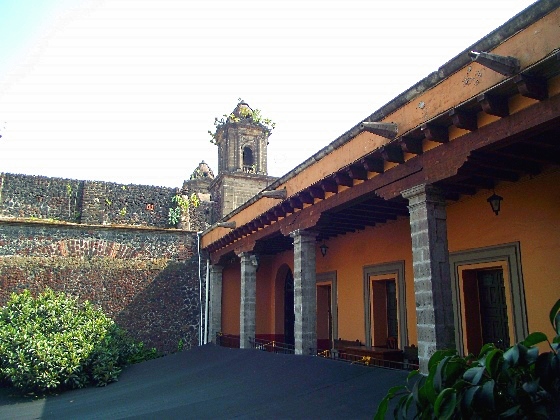Books praise the suburb of Xochimilco. It is a marshy land pretty far away on the south-east side of Mexico City, you have to take Metro line 2 to the last stop Tesquena and then transfer to Tren Ligero TL 17 stops to the very end. It takes over an hour. The problem with TL is how to pay for it – there are no cashiers as in metro stations. You have to have a metro card and add money to that card via the machine. We didn’t have the Metro card, so asked a guy to enter our pesos into his card and help us through the gates with it. We got out 3 stops before the end on La Noria. Walk a little back to the intersection and then you already see Dolores Olmedo Patino Museum -it is a mansion, an ex-hacienda, all enclosed with high walls. So far it was the most beautiful museum we saw. The ticket is 75 pesos, Tuesdays – free. You enter a huge very well cared park:




Then there is a house to the right. This time it was like a skeleton Disneyland :-). Lots and lots of them dressed in funny clothes, caught in doing different activities, even Diego’s mural was depicted by them, colorful, joyful, with different music playing in each hall – maybe it should be called Dia de la Muertes art. Created by a French artist, not a Mexican:
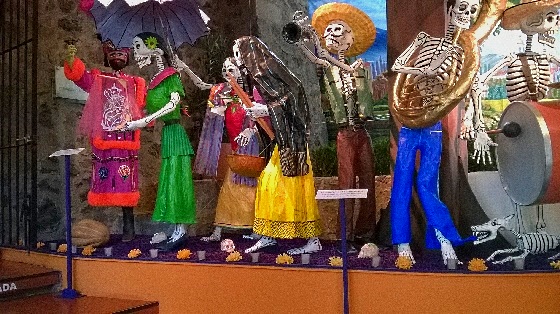 Deeper in the park there is the main house, a real mansion, with a chapel from old times and all those inner yards and gardens. One part of the building is Dolores Olmedo’s living quarters, overfilled with riches, decors and statues from the Orient and numerous big photo portraits of her lined up to the ceiling. With different jewelry, different make ups, but still, this indicated a pretty big ego. Some smaller photos were her with the pope and presidents shaking hands. Only in her bedroom we saw a picture of what seemed her children. So it raised quite a lot of questions. We couldn’t find answers there for obvious reasons, there were no English interpretations, and I could see that the museum workers were not eager to explain who she was, they didn’t feel very proud of her. Only in the evening at home we Googl’ed her and what came out was impressive – this beauty made her big bucks herself, while establishing construction companies, while herself having only music and art education. In her 30ties…She had a husband and 4 children, but the museum is not about them. Diego seems to have been an important friend of hers, therefore she restored parts of Hacienda and made halls for 136 Diego Riviera’s art pieces and only because she knew that Frida’s art is also valuable – she gained 25 pieces of hers. That was basically why we decided to visit the museum in the first place. So here they were -a Mexican Communist party leader and a big capitalist – very good friends or even more. She posed to him naked while still a teenager and that painting is there and it is good. And then he finished his last years of life after he got cancer in her Acapulco mansion. So there is his literally – a line of sunsets on the ocean – Diego could not be just sick, he had to paint till the last. There are also several good of his self-potraits. What a true artist! And Frida- Dolores didn’t like her at all, because Frida was a Communist, as if only because of that, cha cha…
Deeper in the park there is the main house, a real mansion, with a chapel from old times and all those inner yards and gardens. One part of the building is Dolores Olmedo’s living quarters, overfilled with riches, decors and statues from the Orient and numerous big photo portraits of her lined up to the ceiling. With different jewelry, different make ups, but still, this indicated a pretty big ego. Some smaller photos were her with the pope and presidents shaking hands. Only in her bedroom we saw a picture of what seemed her children. So it raised quite a lot of questions. We couldn’t find answers there for obvious reasons, there were no English interpretations, and I could see that the museum workers were not eager to explain who she was, they didn’t feel very proud of her. Only in the evening at home we Googl’ed her and what came out was impressive – this beauty made her big bucks herself, while establishing construction companies, while herself having only music and art education. In her 30ties…She had a husband and 4 children, but the museum is not about them. Diego seems to have been an important friend of hers, therefore she restored parts of Hacienda and made halls for 136 Diego Riviera’s art pieces and only because she knew that Frida’s art is also valuable – she gained 25 pieces of hers. That was basically why we decided to visit the museum in the first place. So here they were -a Mexican Communist party leader and a big capitalist – very good friends or even more. She posed to him naked while still a teenager and that painting is there and it is good. And then he finished his last years of life after he got cancer in her Acapulco mansion. So there is his literally – a line of sunsets on the ocean – Diego could not be just sick, he had to paint till the last. There are also several good of his self-potraits. What a true artist! And Frida- Dolores didn’t like her at all, because Frida was a Communist, as if only because of that, cha cha…
A magnolia flower in an ancient bowl.
Tiny orchids and a Cala Lilly.
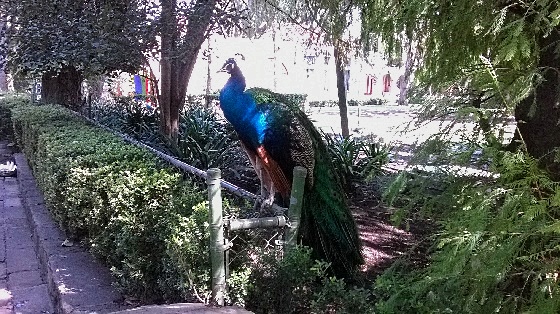 The park was full of life – dozens of peacocks were mingling around, seemed like some park in England. Dolores liked to have them and also geese and chickens and hairless dogs which are now kept in closed gardens and don’t react to visitors whatsoever – they looked like statues, not real dogs:
The park was full of life – dozens of peacocks were mingling around, seemed like some park in England. Dolores liked to have them and also geese and chickens and hairless dogs which are now kept in closed gardens and don’t react to visitors whatsoever – they looked like statues, not real dogs: I guess those dogs were in fashion then. Because Frida also kept them and had them in her self portraits.
I guess those dogs were in fashion then. Because Frida also kept them and had them in her self portraits.
Another peculiar artist whose works are exposed in one of the halls is Angelina – the Russian lady, who was Diego’s kind of a wife while he lived in Europe – she even gave birth to his child and then in 9 months a cold winter killed the baby -a sad story. Angelina came to Mexico after him, he didn’t recognize her… But Dolores Olmedo was smart enough to collect some of her illustrations and here they are, pretty good, only too small for my aging eyes.
 The gardens are also richly decorated with old Indian statues taken from archeological sites… I wonder – how much art was created by ancient Indians and how many of those pieces landed in private collections…I guess that the bigger part. it is good that Dolores left her collection to the public. She did that because of her mother, who was a university professor and that was hes wish.
The gardens are also richly decorated with old Indian statues taken from archeological sites… I wonder – how much art was created by ancient Indians and how many of those pieces landed in private collections…I guess that the bigger part. it is good that Dolores left her collection to the public. She did that because of her mother, who was a university professor and that was hes wish.
We were sorry to leave this Eden, but being so far away we had to rush to see some of Xochimilco. It is a half hour walk on one street, as if the Los Angeles ave., if I remember correctly, and you reach the center, which is nice. Nothing very different than lets say – Coyocan. Maybe not so fancy, no galleries:
Here I am by the statue of the peasant who saw Maria Guadelupa – the legend goes that she left her image on his shirt:
Xochimilko is just a real town, with a square, a church and at some point- vast marshy lands for which it is known. Books say that there are floating gardens and something like canals or waters around them and there were many Embarcaderos with very colorful boats ready to take tourists for a ride in those waters. They say it is very quiet there. But those are not open waters, not like a lake as we expected, more like canals with houses and houses and trees in between, so it didn’t attract us to do the trip, too slow for us hectic and busy people. One of the boats had a Lithuanian name Dalia. They all had little chairs and a table in the middle – floaters are supposed to eat while floating:
So we just looked at the boats and left back to the train back home. Here are some street views of Xochimilko:
 We wanted to grab our luggage from the friendly Tea-house where we stayed and rush to the Downtown to another hotel to stay for 2 more nights. This was already taken. Not bad, another experience! Here it is, Casa San Ildefonso, previously a monastery, with lots of charm from old times. Good prices, breakfast included, just in front of Museo de la Luz on a very quiet street -what else can one want. The rooms were with very high ceilings, some folk art on the walls, 25 canaries in a huge cage in the inner garden where we had breakfast, a lot of rooms for sitting, reading, or even having a meeting. Really -a lot of “wasted” rooms as I would label them. I would highly recommend it for staying:
We wanted to grab our luggage from the friendly Tea-house where we stayed and rush to the Downtown to another hotel to stay for 2 more nights. This was already taken. Not bad, another experience! Here it is, Casa San Ildefonso, previously a monastery, with lots of charm from old times. Good prices, breakfast included, just in front of Museo de la Luz on a very quiet street -what else can one want. The rooms were with very high ceilings, some folk art on the walls, 25 canaries in a huge cage in the inner garden where we had breakfast, a lot of rooms for sitting, reading, or even having a meeting. Really -a lot of “wasted” rooms as I would label them. I would highly recommend it for staying:

 It is also close to a bus stop from where a bus to the airport runs. But again -tickets, where to buy them, have no clue…Maybe it would be a good idea to ask in the hotel about where to buy them – we had a little problem with them, because we planned to buy them in the bus directly. It is not very easy without Spanish language.
It is also close to a bus stop from where a bus to the airport runs. But again -tickets, where to buy them, have no clue…Maybe it would be a good idea to ask in the hotel about where to buy them – we had a little problem with them, because we planned to buy them in the bus directly. It is not very easy without Spanish language.
The next day was a lot of walking. We took metro to the very end of line 3, got out at the university and walked through it. It is a big peace of land, all dotted with lava pieces and wild flora growing on them, lots of fenced paths and roads, when you go and don’t know- will you manage to get through…They have this strange inclination to gate everything. So I wondered- was it so dangerous to live there, and why did I feel so safe, or what is the deal. Maybe it is their habit from old times when they were fighting and fighting and having revolutions:
Those crosses say that students are standing for democracy, liberty and justice.
Inside of one of the libraries. Lower is the main library – so exotic from outside but no art inside:
This decor to me as if was saying that people come to the university with holes in their knowledge and the university fills them up:
From there we walked to San Angel, passed and had lunch in the church of Carmen yard:
The center of San Angel is Plaza Jacinto. It was well worth the effort to go there. A very fancy area, with galleries and restaurants, and beautiful rich houses:
 At last we reached Diego Riviera’s studio built by considered the most famous Mexican architect whose name I forgot. Well, I would argue…but again – it is a matter of taste, and it looks better in photos than in that location:
At last we reached Diego Riviera’s studio built by considered the most famous Mexican architect whose name I forgot. Well, I would argue…but again – it is a matter of taste, and it looks better in photos than in that location:
Frida had her studio in the smaller blue part and Diego in the white-brown buildong. He even lived there. The bridge between buildings is said was built so that Frida could carry lunch to Diego…I highly doubt it. Her with her leg problems -you should be an acrobat to climb those little stairs on the side of the blue building and and also the bridge…As the story goes – the restaurant in front of the house provided them with food and that seems true – it looked very fancy.
From there we walked down the slight slope to avenida Revolucion and reached Museo Carrillo Gill. It is very modern, very big spaces, fits well for big paintings by their outstanding muralists.
We still sneaked a little back to Av. Francisko Sosa, walked a little around the district which is so nice and had our last dinner in this outstanding city in the same Fish restaurant we already knew – Mazatlan. And didn’t get disappointed.






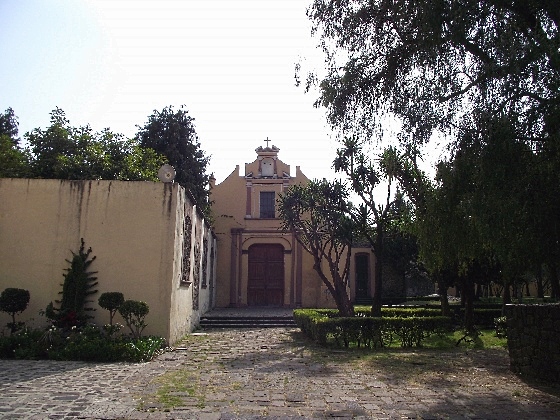



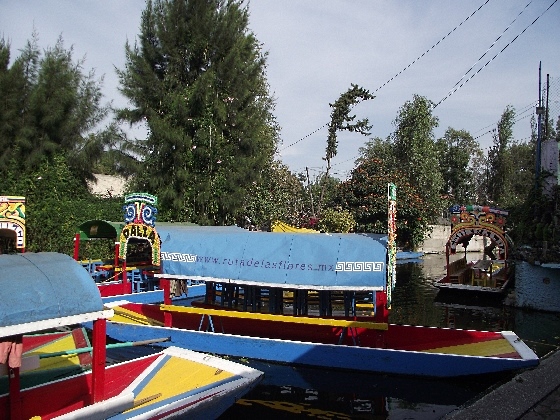









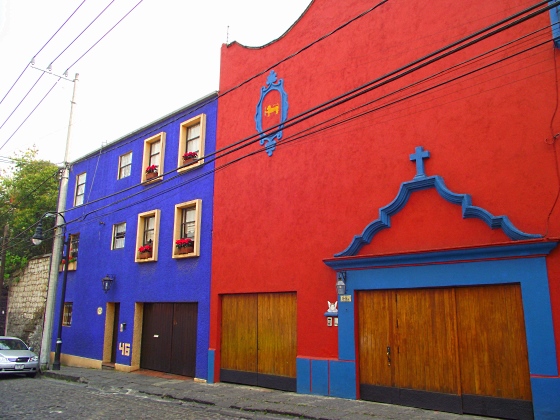











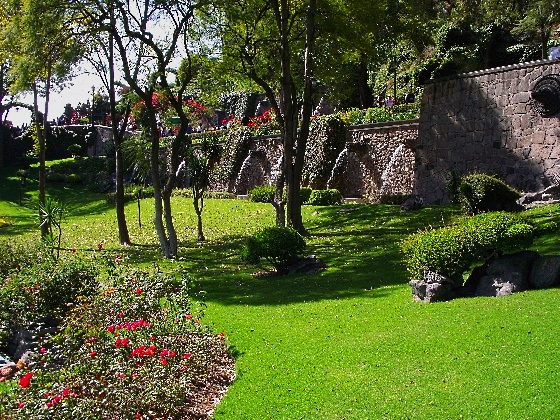




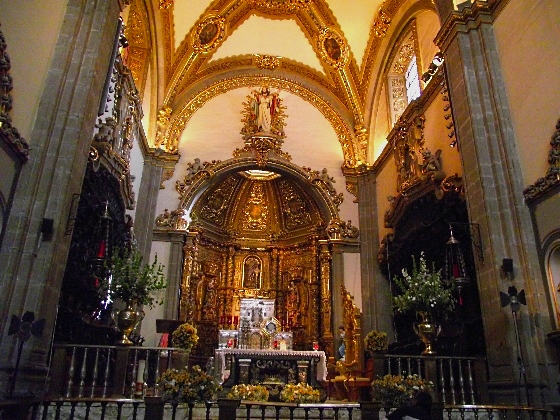



















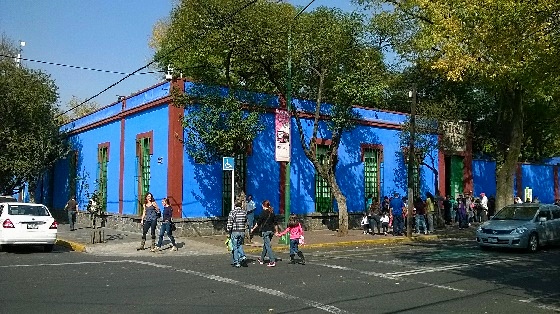

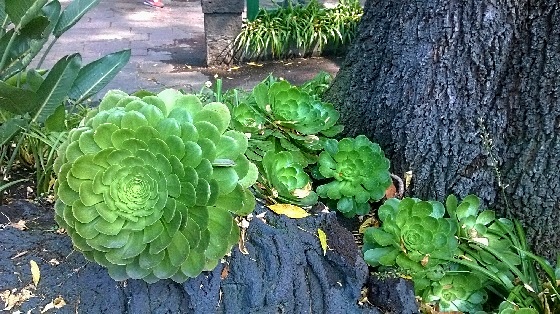

















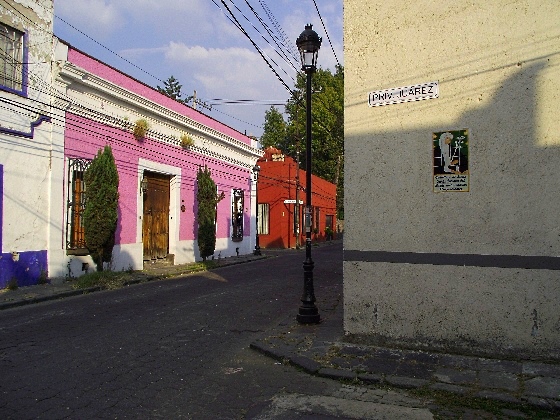







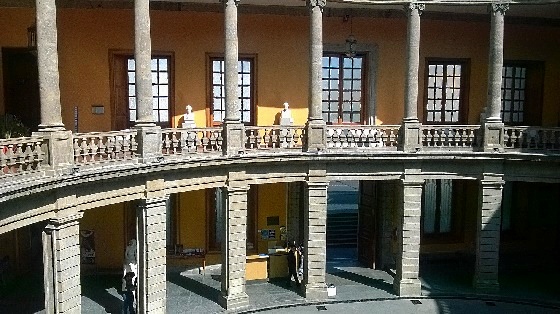








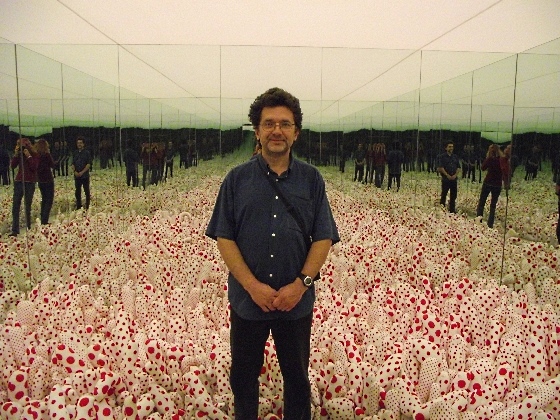



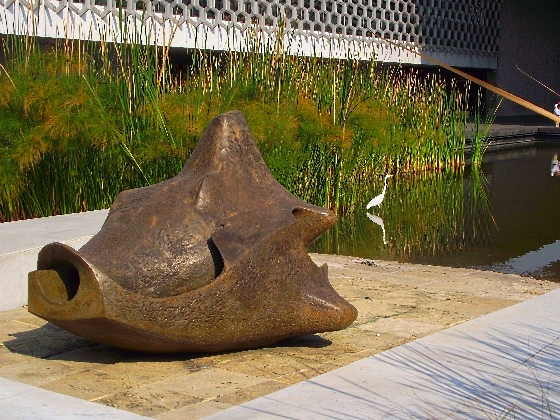
















 And that was too much for a day 🙂
And that was too much for a day 🙂



 How can one not like it!
How can one not like it!







